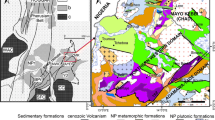Abstract
To improve our knowledge of the structural pattern of Mt. Vesuvius and its magmatic system, which represents one of the three volcanoes located in the Neapolitan area (together with Campi Flegrei and Ischia; southern Italy), we analyze here the Bouguer gravity map that is already available through its interpretation by means of 2.5-dimensional modelling. We have carried out a three-dimensional interpretation using a new and original algorithm, known as ‘Layers’, that has been especially processed for this purpose. Layers works in an automatic and non-subjective way, and allows the definition of the structural settings in terms of several layers, each representing a specific geological formation. The same data are also interpreted in terms of isolated and shallow anomalous density bodies using a well tested algorithm known as ‘Growth’. We focus our inversions on the Mt. Vesuvius volcano, while globally analyzing the entire Neapolitan area, in order to investigate the deep structures, and in particular the deep extended ‘sill’ that has been revealed by seismic tomography.
The final models generally confirm the global setting of the area as outlined by previous investigations, mainly for the shape and depth of the carbonate basement below Mt. Vesuvius. The presence of lateral density contrasts inside the volcano edifice is also shown, which was only hypothesized in the 2.5-dimensional inversion. Moreover, the models allow us to note a high density body that rises from the top of the carbonate basement and further elongates above sea level. This probably represents an uprising of the same basement, which is just below the volcano and which coincides with the VP and VP/VS anomalies detected under the crater. The three-dimensional results also reveal that the two inversion methods provide very similar models, where the high density isolated body in the Growth model can be associated with the rising high density anomaly in the Layers model. Taking into account the density of these modelled bodies, we would also suggest that they represent solidified magma bodies, as suggested by other studies. Finally, we did not clearly detect any deep anomalous body that can be associated with the sill that was suggested by seismic tomography.
Similar content being viewed by others
Author information
Authors and Affiliations
Corresponding author
Rights and permissions
About this article
Cite this article
Berrino, G., Camacho, A.G. 3D Gravity Inversion by Growing Bodies and Shaping Layers at Mt. Vesuvius (Southern Italy). Pure appl. geophys. 165, 1095–1115 (2008). https://doi.org/10.1007/s00024-008-0348-2
Received:
Revised:
Accepted:
Published:
Issue Date:
DOI: https://doi.org/10.1007/s00024-008-0348-2




